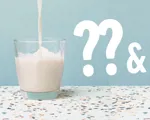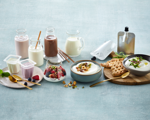
Yes, butter does have lactose. It is made from cream, which is made from milk, and milk contains milk sugar, in other words, lactose.
This delightful staple in most homes is used for cooking, baking, and eating, and regardless of whether you opt for the regular kind or a lactose-free version, it is scrumptious in both sweet and savoury cuisine.
How much lactose is in butter?
Most of the lactose in butter is removed during the production process, so in general, butter only contains about 0.1 grams of lactose per 100 grams.
As mentioned, it is made from cream, which is made by separating the fatty portion from whole milk. The churning process causes the fat globules in the cream to come together and separate from the liquid part: buttermilk.
During this churning process, most of the lactose ends up in the buttermilk. As a result, the butterfat in butter retains only trace amounts of lactose. Interestingly, "buttermilk contains more lactose" than the butter itself, though fermented buttermilk varieties can have reduced lactose levels."
During this churning process, most of the lactose ends up in the buttermilk. As a result, the butterfat in butter retains only trace amounts of lactose.
To dive into the longer explanation of this, check out our articles What is lactose-free milk? and Does cream have lactose?
Different types of lactose-free butter
Picture this: a warm, crusty slice of bread, fresh from the oven, slathered with the creamy goodness of butter. Feel intrigued? Then you should dive into the world of lactose-free butter – with the same flavour and texture you love from the regular kind.
Lactose-free butter is a solid dairy product that has had the lactose removed through a specialised process. Keep reading below to learn more about the different types.

Slightly salted and unsalted butter
Lactose-free unsalted butter and the slightly salted variety are well-known solid butter types that are kitchen staples for many. They are the best types of lactose-free butter for baking and cooking with their rich, creamy goodness.
The slightly salted type offers a subtle and balanced flavour that enriches and enhances the taste of various dishes. It is made by incorporating a small amount of salt into it, adding a delicate touch of savoury depth to bring out the flavours of baked goods and other recipes.
Unsalted butter does not contain any added salt or other additional flavourings. This makes it a versatile ingredient in cooking and baking, as it allows for more precise control over the overall saltiness of a dish and makes it slightly sweeter, too.
This is especially great in sweet cakes and pastries or when preparing delicate-tasting sweet sauces and frostings.
Lactose free spreadable butter
Lactose-free spreadable has become a popular choice due to its smooth and soft consistency. It is very convenient as you can easily spread it onto bread and toast, even when it comes straight from the fridge.
It typically includes ingredients such as lactose-free butter, vegetable oil, water, salt, and lactic acid culture, but it can also be made with lactose-free cream or milk instead of oil. Note that the name ‘butter’ requires that the product meets certain requirements and spreadable is therefore not butter.
What butter is lactose-free?
When you are looking for the best lactose-free butter for you, you will need to check the product labels or consult with the manufacturer to ensure that a specific product is lactose-free.
First, look for 'lactose-free' or similar statements on the label. Many brands that produce lactose-free butter will indicate it on the packaging. These statements assure consumers that the product is specifically formulated to be either low or free from lactose, depending on your country’s specific rules and regulations.
Second, you can check the ingredients list. Review the list to ensure that there are no lactose-containing ingredients listed. In traditional butter, the sole ingredient is typically cream. However, in lactose-free butter, the label may list modified or specialised dairy ingredients, such as lactose-free cream, to indicate its lactose-free nature.
How to make lactose-free butter?

Making lactose-free butter is a straightforward process and the key is to replace regular cream with lactose-free cream, which has already gone through the process of removing or breaking down lactose. This feat is accomplished through an enzymatic treatment, where a lactase enzyme is added to break down lactose into glucose and galactose.
Then the cream is churned to make the fat come together and separate from the liquid part called buttermilk. The remaining solidified fat is called butterfat, and this is what is used to make butter – in this case, it has no lactose because of the cream’s initial process of breaking down the milk sugar, giving you lactose-free butter.
The process might vary, but the steps above are typical for making lactose-free butter with a velvety texture and delicious flavour.
Does lactose-free butter contain dairy?
Yes, lactose-free butter still contains dairy. Removing the naturally occurring lactose from cream or milk to produce a given lactose-free product does not change the fact that it has a dairy base.
Since lactose-free butter is made from cream, a milk derivative, it is still considered a dairy product. To learn more about this, you can read our article about the difference between lactose-free and dairy-free.











































